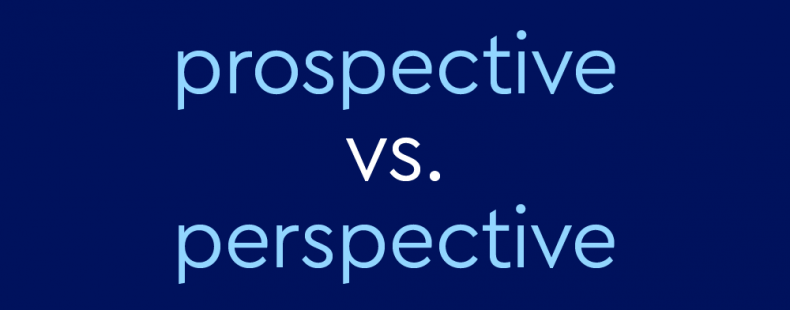The difference between prospective and perspective is all in how you look at it.
Prospective is used in the context of looking ahead to what might happen in the future. Perspective is used in the context of viewpoints or the position from which something is viewed.
The difference can be confusing, especially since they sound so much alike. We’ll break down the difference in meaning, discuss some of the common ways in which each word is used, and provide some perspective on these prospective additions to your vocabulary!
⚡ Quick summary
Prospective has to do with what might happen in the future—it means potential, likely, or expected, as in prospective students or prospective customers. Perspective relates to viewpoint—it can refer to a physical viewpoint, a personal point of view, or a technique used in art.
What does prospective mean?
Prospective most generally means “of or in the future.” Most commonly, it means “potential, likely, or expected.” It’s used to describe something that might happen—or that you expect to happen—in the future.
Schools try to recruit prospective students to attend. Prospective clients are potential clients—those you want to become clients. Prospective earnings are earnings you haven’t earned yet but hope to.
The more general sense of the word is used to describe things that relate to the future. A prospective view is one that looks toward the future and what may happen. But don’t confuse that with perspective.
What does perspective mean?
Perspective has several meanings that all involve viewpoints (including literal and more figurative ones).
In the context of viewing physical objects, perspective is “the appearance of objects relative to each other, as determined by their distance from the viewer.” A building looks a lot bigger when you’re standing next to it than it does from a mile away. That difference is due to perspective.
This principle is applied in visual art. Artists use perspective to make objects in two-dimensional artwork appear three-dimensional (by suggesting depth or distance).
More generally, perspective refers to the position from which something is viewed, as in I think we’ll get a better perspective from the roof. This sense of the word can also be used in the context of art to refer to the position from which the subject of an artwork has been depicted—from below or from a bird’s eye view, for example.
It can also be used in a figurative way to refer to a person’s point of view, especially one based on their knowledge, experience, and background, as in I’d like to hear Jane’s perspective on the matter.
Sometimes, the word perspective is used to mean about the same thing as objectivity—the proper or accurate point of view or the ability to see it, as in Hopefully this new information will give you some perspective. This is what people mean when they tell you to put a situation in perspective.
Where do prospective and perspective come from?
Perspective relates to looking at things, and prospective involves prospects, and this is true for their origins, too.
Perspective comes from the Latin perspectīvus, meaning “optical,” from the verb perspicere, “to look at closely,” from specere, “to look at”—the words spectacle and spectacles (as in glasses) also come from this root.
Prospective comes from the Latin prōspectus, “distant view,” from the verb prōspicere, “to look into the distance”—the pro- part means “forward,” as in, into the future. The word prospect comes from the same root.
How to use prospective vs. perspective
Prospective is used in situations involving possibilities and prospects. Perspective is used in situations involving viewpoints.
One way to remember the difference between prospective versus perspective is to remember that pro- means “forward” and forward means “future.” Another way is to remember that perspective is usually used as a noun, while prospective is always used as an adjective (in terms like prospective students and prospective customers).
Examples of prospective and perspective used in a sentence
Here are some example sentences of prospective and perspective used in typical ways.
- Part of drawing class is perfecting perspective to ensure realistic rendering.
- From a parent’s perspective, the world is full of danger, but from a child’s perspective, it all looks like adventure.
- We need to make sure our existing customers are happy while also trying to entice prospective customers.
- When considering prospective business partners, remember to seek out those whose perspective is different from your own so you can have a diversity of viewpoints.














